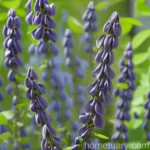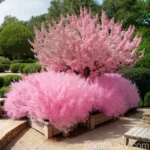The Marvelous Golden Shower Tree (Cassia fistula)
Welcome, plant enthusiasts, to another intriguing dive into the breathtaking world of plants! This time, we are going to uncover the fascinating secrets of the golden shower tree, scientifically known as Cassia fistula. This tropical flowering tree boasts not only stunning yellow blooms but also a plethora of cultural, medicinal, and ecological significance. Throughout history, it has captured the hearts of many with its vibrant display of golden cascading flowers, making it a beloved addition to gardens, landscapes, and even urban environments. Join me on this botanical journey as we explore the mesmerizing beauty and the invaluable contributions of this extraordinary tree.
What is the Golden Shower Tree (Cassia Fistula)?
The golden shower tree, also known as Cassia fistula, is a species of flowering plant in the family Fabaceae. Native to the Indian subcontinent and Southeast Asia, this magnificent tree is celebrated for its long, pendulous clusters of bright yellow flowers that drape elegantly from its branches. The scientific name Cassia fistula is derived from Latin, wherein “cassia” refers to a type of cinnamon and “fistula” means pipe, alluding to the cylindrical shape of its fruit.
Botanical Information
Let’s explore the botanical details of this captivating tree:
- Scientific Name: Cassia fistula
- Common Names: Golden shower tree, Golden rain tree, Indian laburnum, Yellow shower tree
- Family: Fabaceae
- Native Habitat: Indian subcontinent, Southeast Asia
- Growth Habit: Deciduous tree
- Flower Color: Golden yellow
- Maximum Height: Up to 40 feet
- Bloom Time: Late spring to early summer
- Fruit: Long, dark brown pods
The golden shower tree holds immense cultural significance, being the national tree of Thailand and the state flower of Kerala in India. Its impressive stature, adorned with cascades of golden blossoms, has earned it a place in gardens, parks, and landscapes worldwide.
Key Takeaways – Golden Shower Tree (Cassia Fistula)
Before we delve deeper into the realms of cultivation, uses, and ecological significance, let’s summarize the key takeaways about the golden shower tree (Cassia fistula).
- Botanical Name: Cassia fistula
- Common Names: Golden shower tree, Golden rain tree, Indian laburnum, Yellow shower tree
- Family: Fabaceae
- Native Habitat: Indian subcontinent, Southeast Asia
- Flower Color: Golden yellow
- Cultural Significance: National tree of Thailand, State flower of Kerala, India
- Growth Habit: Deciduous tree
- Blooming Season: Late spring to early summer
- Fruit: Long, dark brown pods
Now, let’s embark on an enlightening journey through the culture, uses, and essential care tips for the golden shower tree.
Culture
Understanding the cultural requirements of the golden shower tree is vital for ensuring its optimal growth and blooming. Here’s a comprehensive guide to provide the ideal environment for this magnificent tropical tree.
- USDA Hardiness Zones: 9-11
- Temperature: Thrives in warm climates, sensitive to frost
- Humidity: Prefers moderate to high humidity levels
- Wind Tolerance: Requires protection from strong winds
- Toxicity: All parts of the tree, including the seeds and pods, are toxic if ingested
The golden shower tree flourishes in tropical and subtropical regions, where it can bask in ample sunlight and warmth. Now that we have explored its cultural requirements, let’s move on to the essential aspects of nurturing this captivating tree.
Uses
The golden shower tree boasts a diverse range of uses, encompassing ornamental, medicinal, and cultural applications. Let’s unravel the myriad ways in which this extraordinary tree enriches our lives.
Ornamental Beauty
The primary allure of the golden shower tree lies in its stunning visual appeal. The cascading clusters of bright yellow flowers create a captivating spectacle, making it a sought-after ornamental tree in gardens, parks, and public spaces. Its picturesque display during the blooming season adds a touch of vibrancy and elegance to any landscape.
Medicinal Properties
In addition to its ornamental value, various parts of the golden shower tree hold medicinal significance in traditional herbal medicine systems. The bark, flowers, and pulp of the pods are utilized in herbal remedies for their purported therapeutic properties. In Ayurveda, the traditional medicine of India, the tree is known for its laxative and antipyretic properties.
Cultural Significance
The golden shower tree is deeply intertwined with cultural and religious customs in several countries across its native range. In Thailand, it is revered as a sacred tree, and its flowers are often used in auspicious ceremonies and traditional medicine. Similarly, in India, the tree holds cultural and religious significance, with its flowers symbolizing purity and spirituality.
Environmental Benefits
Beyond its aesthetic and medicinal value, the golden shower tree contributes to the ecological balance in its habitat. As a flowering tree, it provides a vital food source for pollinators, including bees and butterflies. Its role in supporting biodiversity and enhancing the natural landscape underscores its ecological significance.
Essential Care Tips
To ensure the optimal growth and health of the golden shower tree, it’s essential to provide it with the right care and maintenance. Let’s explore the key aspects of caring for this stunning tropical flowering tree.
Water
- Watering Frequency: Requires regular watering, especially during the growing season
- Soil Moisture: Well-draining soil to prevent waterlogging
- Established Trees: Drought-tolerant once established, but benefits from occasional deep watering in dry spells
The golden shower tree thrives in moist soil, especially during its active growth period. Adequate and consistent watering is crucial for fostering lush foliage and prolific flowering.
Sunlight
- Sun Exposure: Full sun to partial shade
- Optimal Light: Thrives in bright, direct sunlight for at least 6-8 hours per day
As a sun-loving tree, the golden shower tree flourishes in warm, sunny locations. Providing ample sunlight is essential for promoting healthy growth and profuse blooming.
Fertilizer
- Fertilization Schedule: Apply a balanced fertilizer in early spring and late summer
- Nutrient Requirements: Requires a fertilizer with a balanced NPK ratio to support foliage and flower production
- Organic Amendment: Incorporate organic matter into the soil to enhance nutrient retention
Regular fertilization with a balanced fertilizer helps provide the golden shower tree with essential nutrients, supporting robust growth and vibrant blooms.
Soil
- Soil Type: Well-draining loamy soil
- Soil pH: Neutral to slightly acidic soil (pH 6.0-7.5)
- Soil Amendments: Adding organic matter improves soil structure and fertility
Optimal soil conditions, characterized by good drainage and nutrient-rich composition, are vital for the health and vigor of the golden shower tree.
Pruning
- Pruning Time: Best performed after the flowering season
- Objective: Remove dead or damaged branches, shape the tree, and maintain desired size
- Sanitization: Use clean, sharp pruning tools to prevent the spread of diseases
Pruning plays a crucial role in shaping the tree’s growth, enhancing its form, and removing any weak or diseased branches, ensuring its continued vitality.
Propagation
- Propagation Methods: Seeds, cuttings, or air layering
- Seed Propagation: Sow fresh seeds in well-draining soil
- Cutting Propagation: Use semi-hardwood cuttings for propagation
- Air Layering: Encourage root formation on a stem while still attached to the parent plant
Understanding the various propagation methods empowers plant enthusiasts to propagate and share the beauty of the golden shower tree with others.
Container Popularity
- Container Size: Large-sized containers or planters
- Soil Requirements: Well-draining potting mix
- Pruning and Root Pruning: Necessary for managing the size of the tree in containers
Growing the golden shower tree in containers offers the flexibility of enjoying its beauty in smaller spaces, provided the specific care needs of container plants are met.
Common Diseases
Although the golden shower tree is generally resilient, it is susceptible to certain diseases that can impact its health and vitality. Understanding these common diseases and their prevention is crucial for safeguarding the tree’s well-being.
Disease Diagnosis
- Fungal Diseases: Anthracnose, powdery mildew
- Symptoms: Leaf spots, powdery growth on leaves, wilting, and dieback
- Preventive Measures: Proper plant spacing, good air circulation, and fungicidal treatments
Vigilant monitoring, timely diagnosis, and appropriate preventive measures are essential for combatting potential disease issues effectively.
Common Pests
While the golden shower tree is relatively resistant to pests, certain insects and pests may pose a threat to its overall health. Identifying and addressing these common pests is crucial for maintaining the tree’s vitality.
Pest Identification
- Insect Pests: Aphids, caterpillars, scale insects
- Symptoms: Presence of pests on leaves, stunted growth, and yellowing foliage
- Control Measures: Natural predators, horticultural oils, insecticidal soaps
Implementing sustainable pest management practices helps protect the tree from potential pest damage without harming beneficial insects or the environment.
Botanist’s Tips
As botanists, we can offer valuable insights and tips to plant enthusiasts and horticulturists to enhance their understanding and appreciation of the golden shower tree. Here are some expert recommendations to foster the optimal growth and care of this remarkable tropical tree.
- Selecting Varieties: Explore different cultivars and varieties to introduce diversity to garden landscapes
- Integration in Landscaping: Incorporate the golden shower tree into diverse landscapes, including urban environments, parks, and public spaces
- Cultural Significance: Embrace the cultural and symbolic value of the tree and its flowers in diverse traditions and ceremonies
- Pollinator Support: Encourage the planting of golden shower trees to provide essential forage for pollinators and support biodiversity
- Disease Prevention: Emphasize good cultural practices, such as proper watering and spacing, to minimize disease incidence
By sharing our knowledge and expertise, we can inspire a deeper appreciation for the golden shower tree and its invaluable contributions to horticulture and the natural world.
Fun Facts
Uncover the fascinating and intriguing facts that enrich our understanding of the golden shower tree and its captivating attributes.
- In folklore and mythology, the golden shower tree is associated with various legends and tales, often symbolizing hope, prosperity, and purity.
- The long, cylindrical pods of the tree contain dark, spherical seeds that are utilized in various traditional practices and crafts.
- The golden shower tree’s flowers are celebrated for their inclusion in traditional dye production, yielding a vibrant yellow dye used in textiles and artwork.
Links to External Resources
For further exploration and in-depth knowledge about the golden shower tree, consider exploring the following external resources:
- Cassia Fistula: A Review on Its Ethnobotany, Phytochemical and Pharmacological Profile – An insightful academic review exploring the ethnobotanical, phytochemical, and pharmacological aspects of Cassia fistula.
- National Parks Board, Singapore – Cassia Fistula – A comprehensive guide to the golden shower tree by the National Parks Board of Singapore, featuring detailed botanical information and cultivation tips.
- Traditional and Medicinal Uses of Cassia Fistula – A scholarly article delving into the traditional and medicinal uses of Cassia fistula in the context of ethnobotanical practices.
Conclusion
In conclusion, the golden shower tree, scientifically known as Cassia fistula, presents a captivating tapestry of ornamental beauty, cultural significance, and ecological contributions. From its radiant yellow blooms to its revered status in traditional medicine and folklore, this tropical flowering tree continues to enamor plant enthusiasts and nature lovers worldwide. By understanding its culture, care needs, and diverse uses, we can nurture and celebrate the enduring splendor of the golden shower tree, ensuring its legacy flourishes for generations to come.
Join us on this botanical odyssey and let the golden shower tree inspire a deeper appreciation for the marvels of the natural world!















